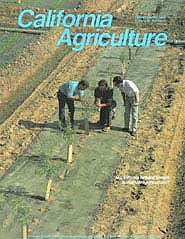All Issues

Is California headed toward sustainable agriculture?
Cover:
IPM area advisor Jim Stapleton (center) has shown that polyethylene mulch can reduce water use and Verticillium wilt in first-year almond and apricot orchards. Scattered Central Valley farmers are beginning to adopt this sustainable practice. Also pictured are postgraduate researchers Roger Duncan (left) and Abraham Gamliel (right).
Photo by Jack Kelly Clark
March-April 1992
Volume 46, Number 2
Volume 46, Number 2





